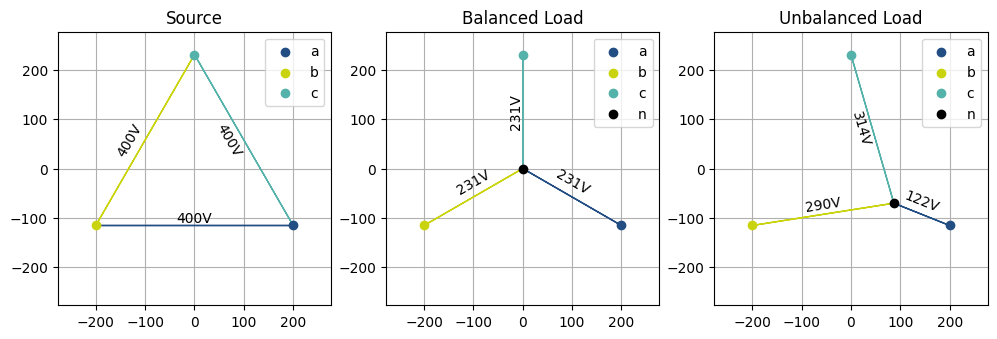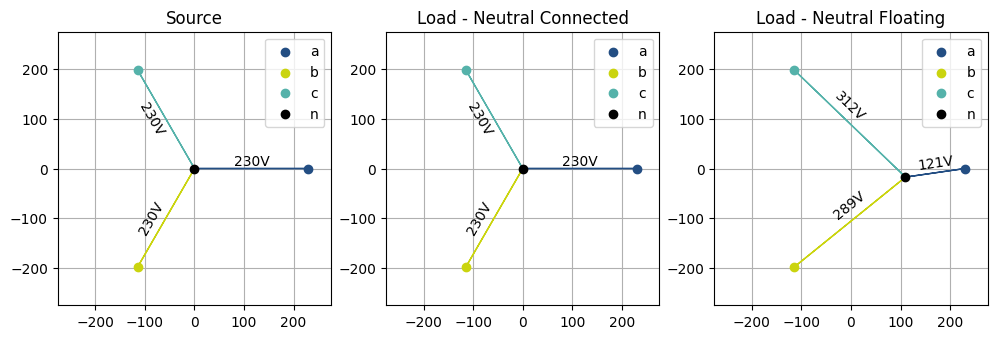Floating Neutral¶
What is floating neutral¶
A “floating” neutral occurs when the neutral wire, crucial for balancing electrical loads, becomes disconnected or loose. This can happen within the electrical panel or between the utility and the panel due to mechanical failure, corrosion, or other factors. This condition is hazardous because it disrupts the normal voltage distribution across electrical components. As a result, some appliances may receive excessive voltage while others receive insufficient power. In severe cases, outlets can become dangerously energized with full phase-to-phase voltage, posing a significant risk of equipment damage, electric shock, or fire.
With a perfectly balanced load, the neutral current is zero and the neutral voltage is zero as well. With an unbalanced load, the neutral current is non-zero. In this case, it is the role of the neutral to balance the voltage across the electrical phases. In a floating neutral situation, the phase-to-phase voltages remain normal, but the 0V reference of the neutral gets lost. The larger the load imbalance, the more serious the issue becomes.
Modelling floating neutral in Roseau Load Flow¶
Roseau Load Flow offers an intuitive interface for modelling floating neutrals.
Implicit floating neutral¶
When defining a load or a source with a neutral connection (e.g., 3-phase load with phases “abcn”), on a bus without a neutral port (e.g., 3-phase bus with phases “abc”), the neutral is implicitly floating. This is because the bus doesn’t have a neutral to connect to.
import matplotlib.pyplot as plt
import roseau.load_flow as rlf
from roseau.load_flow.plotting import plot_voltage_phasors
# Define a bus without a neutral
bus = rlf.Bus("Bus", phases="abc")
source = rlf.VoltageSource("Source", bus=bus, voltages=rlf.Q_(400, "V"))
# Define a balanced and an unbalanced load with a neutral. Their neutral is
# implicitly floating because the bus doesn't have a neutral.
z = rlf.Q_(50 + 500j, "ohm")
balanced_load = rlf.ImpedanceLoad("Balanced Load", bus=bus, impedances=z, phases="abcn")
unbalanced_load = rlf.ImpedanceLoad(
"Unbalanced Load", bus=bus, impedances=[z, 3 * z, 5 * z], phases="abcn"
)
pref = rlf.PotentialRef("PRef", element=bus)
en = rlf.ElectricalNetwork.from_element(bus)
en.solve_load_flow()
fig, axes = plt.subplots(1, 3, figsize=(12, 4))
plot_voltage_phasors(source, ax=axes[0])
plot_voltage_phasors(balanced_load, ax=axes[1])
plot_voltage_phasors(unbalanced_load, ax=axes[2])
plt.show()

Notice that although the bus doesn’t have a neutral, loads connected to this bus can have a neutral connection. This is because the neutral of a load or source is implicitly considered floating.
The plots of the voltage phasors above show what happens to the potential at the neutral point when the neutral is floating. For the balanced load, the neutral remains at the center of the phasor diagram, while for the unbalanced load, the neutral moves away from the center towards the phase with the lowest impedance. The phase with the highest impedance (i.e with the lowest power) is the one exposed to the highest voltage.
Explicit floating neutral¶
You can explicitly define a floating neutral by passing connect_neutral=False to the constructor
of a load or source element. This is useful for modelling both elements with floating neutrals and
elements with connected neutrals on the same bus.
import matplotlib.pyplot as plt
import numpy as np
import roseau.load_flow as rlf
from roseau.load_flow.plotting import plot_voltage_phasors
# Define a bus with a neutral
bus = rlf.Bus("Bus", phases="abcn")
source = rlf.VoltageSource("Source", bus, voltages=rlf.Q_(230, "V"))
# Define two unbalanced loads, one with connected neutral and one with floating neutral
z = rlf.Q_(50 + 500j, "ohm") * np.array([1, 3, 5]) # different impedance on each phase
connected_load = rlf.ImpedanceLoad(
"Load - Neutral Connected", bus, impedances=z, connect_neutral=True
)
floating_load = rlf.ImpedanceLoad(
"Load - Neutral Floating", bus, impedances=z, connect_neutral=False
)
pref = rlf.PotentialRef("PRef", element=bus)
en = rlf.ElectricalNetwork.from_element(bus)
en.solve_load_flow()
fig, axes = plt.subplots(1, 3, figsize=(12, 4))
plot_voltage_phasors(source, ax=axes[0])
plot_voltage_phasors(connected_load, ax=axes[1])
plot_voltage_phasors(floating_load, ax=axes[2])
plt.show()

Notice that here even though the bus has a neutral, we can have loads with connected or floating neutrals connected to this bus.
In the plots above, the neutral of the connected load remains at the center of the phasor diagram, even though the load is unbalanced. In this case, the neutral potential is fixed by the source and the voltages remain balanced. On the other hand, the neutral of the load with a floating neutral drifts away from the center towards the phase with the lowest impedance as we saw before.
Note
Be careful with passing connect_neutral=True on a bus without a neutral. This will raise an error
because the neutral cannot be connected:
>>> import roseau.load_flow as rlf
>>> bus = rlf.Bus("Bus", phases="abc")
>>> rlf.ImpedanceLoad("Load", bus, impedances=50, phases="abcn", connect_neutral=True)
RoseauLoadFlowException: Phases ['n'] of load 'Load' are not in bus 'Bus' phases 'abc' [bad_phase]